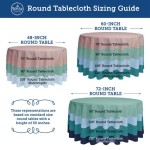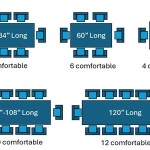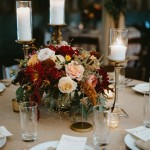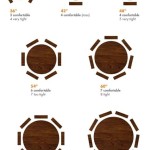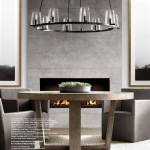Round Table Seating For 8: All You Need To Know
Round table seating for eight individuals presents a compelling option for fostering communication, promoting equality, and creating an inclusive atmosphere in various settings. From dining rooms and conference halls to collaborative workspaces, the circular configuration encourages open dialogue and shared experiences. Understanding the nuances of selecting the appropriate round table, arranging seating effectively, and optimizing the surrounding environment is crucial for maximizing the benefits of this specific setup. This article delves into the key considerations for round table seating for eight, offering practical guidance for achieving both functional and aesthetic success.
The choice of a round table for eight carries significant implications for the dynamics of interaction. Unlike rectangular or square tables, a circular form eliminates the concept of a "head" of the table, thereby minimizing perceived hierarchies. This egalitarian structure implies that each participant holds equal status and has an equal opportunity to contribute to the conversation. In contrast, a longer table, particularly if used for formal meetings or dining, often creates a power dynamic where those seated at the ends are regarded as more influential. The round table subtly dismantles this perception, encouraging a more collaborative and participatory environment.
Selecting the Right Round Table for Eight
The selection process requires careful consideration of several factors, including the intended use, available space, material, and overall aesthetic. A round table designed for dining may differ significantly from one intended for conference meetings. For example, a dining table might prioritize elegance and visual appeal, while a conference table might emphasize functionality and durability. The key is to align the table's characteristics with the specific needs of the environment and the anticipated activities.
The size of the round table is arguably the most critical aspect. While the specific dimensions may vary slightly depending on the design and manufacturer, a general guideline suggests a diameter of at least 60 inches (5 feet) and ideally closer to 72 inches (6 feet) to comfortably accommodate eight individuals. This allows for adequate personal space and prevents a feeling of overcrowding. Measure the available space in the room meticulously before making a purchase. A table that is too large will make the room feel cramped and hinder movement, while a table that is too small will compromise comfort and functionality. Consider leaving at least 36 inches of clearance around the table to allow for easy access and passage.
The material of the table significantly impacts its durability, aesthetic appeal, and maintenance requirements. Wood, particularly hardwoods like oak, maple, and walnut, offers a classic and timeless aesthetic. Wood tables are generally durable and can be refinished to maintain their appearance over time. However, they can be susceptible to scratches, stains, and water damage if not properly cared for. Glass tables offer a modern and sophisticated look, and they are easy to clean and maintain. However, they can be prone to fingerprints and smudges, and they might not be as durable as wood tables. Metal tables, often constructed from steel or aluminum, are highly durable and resistant to scratches and stains. They can provide a contemporary industrial aesthetic, but they might not be as warm or inviting as wood or glass. Laminate tables offer a cost-effective alternative that is easy to clean and maintain. However, they might not be as aesthetically pleasing or durable as other options.
The overall aesthetic of the table should complement the existing décor of the room. Consider the style, color scheme, and other furniture in the space when making your selection. A formal dining room might benefit from a classic wooden table with ornate detailing, while a modern conference room might be better suited to a sleek glass or metal table.
Arranging Seating Effectively
Once the round table has been selected, arranging the seating is crucial for optimizing comfort and promoting effective communication. Several factors should be considered, including the type of chairs, the spacing between them, and any potential obstructions that might hinder movement or visibility.
The choice of chairs significantly impacts the overall comfort and functionality of the seating arrangement. Consider the height of the table and the height of the chairs to ensure that individuals can sit comfortably without straining their neck or back. Chairs should also be chosen based on the intended use of the table. For example, a dining table might be paired with upholstered chairs for added comfort, while a conference table might be paired with ergonomic chairs that provide good support for prolonged periods of sitting.
Spacing between chairs is essential for allowing adequate personal space and preventing a feeling of overcrowding. Aim for at least 24 inches of space between each chair. This will allow individuals to sit comfortably and move freely without bumping into their neighbors. Ensure that chairs are positioned evenly around the table to maintain a balanced and harmonious aesthetic.
Consider any potential obstructions that might hinder movement or visibility. Avoid placing the table in a location where it blocks doorways or walkways. Make sure that individuals seated at the table have a clear view of any presentation screens or whiteboards. If possible, provide ample lighting to ensure that everyone can see each other clearly and comfortably.
Optimizing the Surrounding Environment
The surrounding environment plays a significant role in shaping the overall experience of round table seating. Factors such as lighting, acoustics, and décor can influence mood, concentration, and communication. Careful attention to these elements can help to create a more conducive and productive atmosphere.
Lighting is a critical element in any space, and it is particularly important in areas where individuals are expected to interact and collaborate. Natural light is always preferable, but if natural light is limited, artificial lighting should be carefully planned to provide adequate illumination without creating glare or shadows. Consider using a combination of ambient lighting, task lighting, and accent lighting to create a well-balanced and visually appealing environment. Ambient lighting provides overall illumination, while task lighting focuses on specific areas, such as the table itself. Accent lighting can be used to highlight architectural features or artwork.
Acoustics are often overlooked, but they can significantly impact the ability to hear and understand each other. In rooms with hard surfaces, such as concrete floors or bare walls, sound can reverberate, making it difficult to concentrate and communicate effectively. To improve acoustics, consider adding soft surfaces, such as rugs, curtains, or upholstered furniture. Acoustic panels can also be installed on walls or ceilings to absorb sound and reduce reverberation. In office settings or public spaces, consider strategically placed sound dampening materials to mitigate background noise.
The décor of the room can also influence mood and productivity. Choose colors and patterns that are calming and inviting. Avoid clutter and keep the space clean and organized. Consider adding plants or artwork to create a more visually appealing and stimulating environment. Personalize the space to reflect the unique character of the individuals who will be using it.
Furthermore, consider the temperature of the room. Ensure that the room is adequately heated or cooled to maintain a comfortable temperature for everyone. Provide adequate ventilation to ensure that the air is fresh and clean. Consider adding a source of background noise, such as a fountain or a white noise machine, to help mask distracting sounds.
In conclusion, round table seating for eight offers a valuable approach to fostering communication and collaboration. By carefully considering the selection of the table, the arrangement of seating, and the optimization of the surrounding environment, it is possible to create spaces that are both functional and aesthetically pleasing. These considerations, when implemented thoughtfully, contribute to a more engaging and productive experience for all participants.

59 In White Rotable Lazy Susan Sintered Round Stone Tabletop Black Pedestal Base Kitchen Dining Table Seats 8
Masonic Temple Theatre Seating Chart Seat Views Seatgeek

Florence Knoll 96 X 54 Oval Table Desk

8211 Stewart Mediterranean Kitchen Los Angeles By Blu And White Houzz

Noble House Malta Gray 7 Piece Faux Rattan Rectangular Outdoor Patio Dining Set With Silver Cushions 8211

Merrick Lane Stora Three Piece Solid Acacia Wood Folding Patio Bistro Set With Lightweight Round Table And Two Chairs Natural

Elegant Cabin Views Hot Tub Firepit Cabins For In Blue Ridge Georgia United States Airbnb

Lifetime Plastic Round Picnic Table Almond 260205

Berlin Gardens Harbor 38 Round Table Counter Height Hammered Broe On Driftwood Gray By Amish Yard

6 Piece Solid Wood Dining Room Set Kitchen Table With 4 Chairs And 1 Bench 36 X 54 Gray Rectangle For
Related Posts

